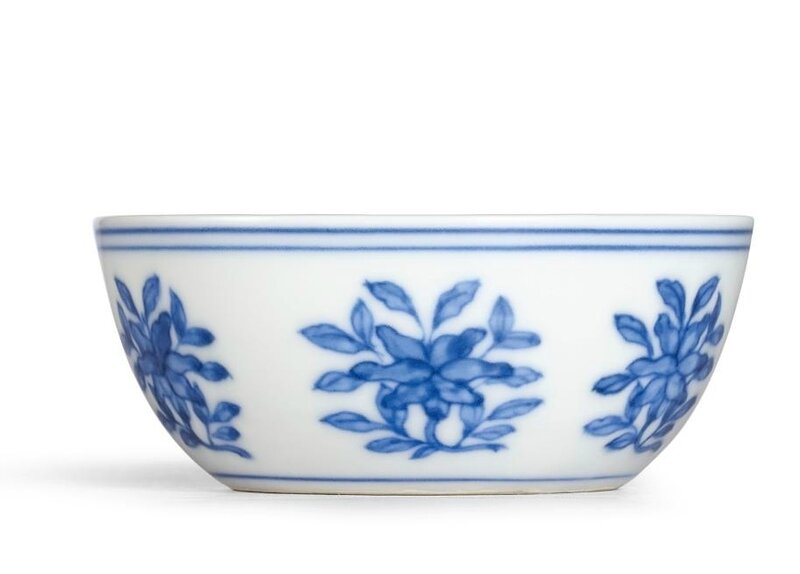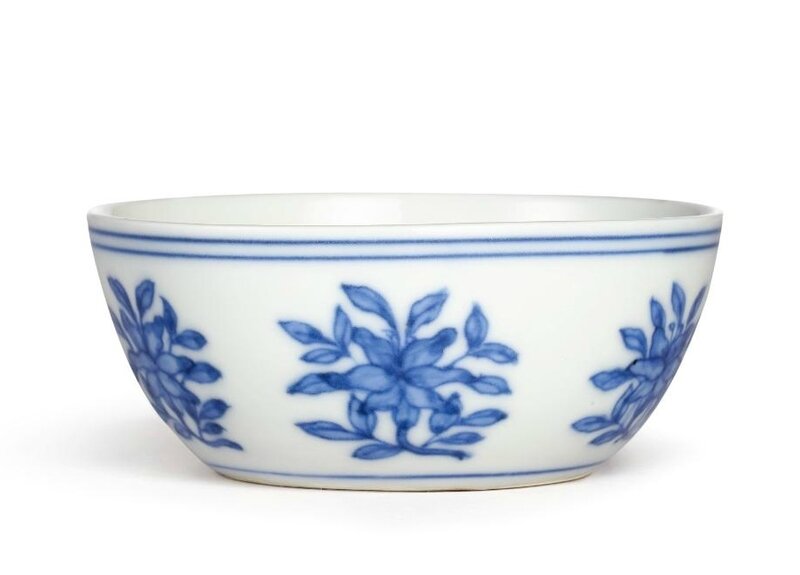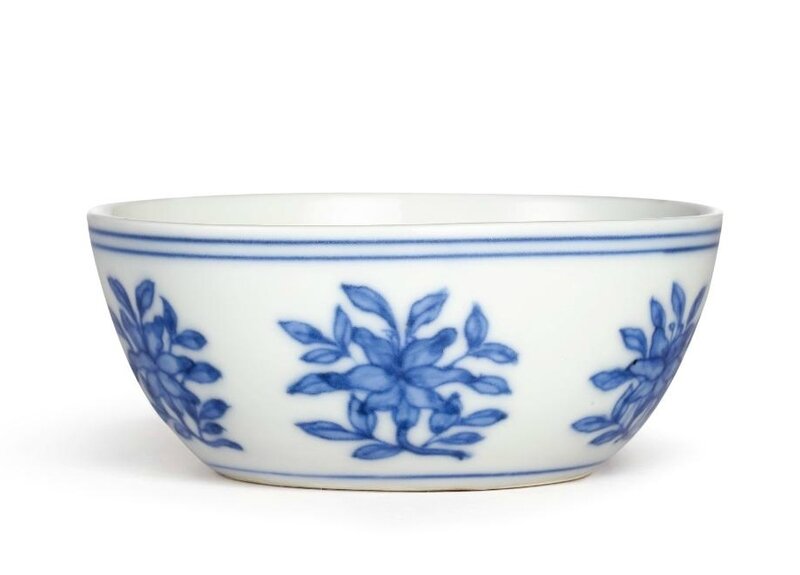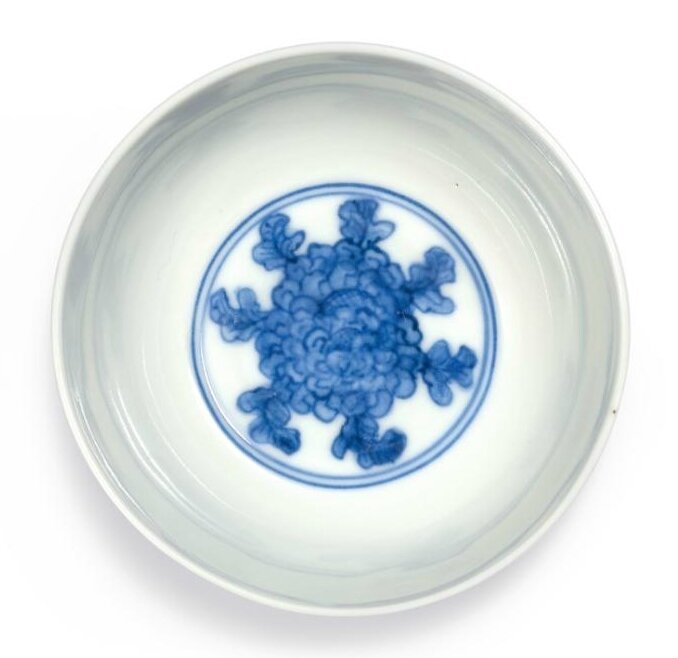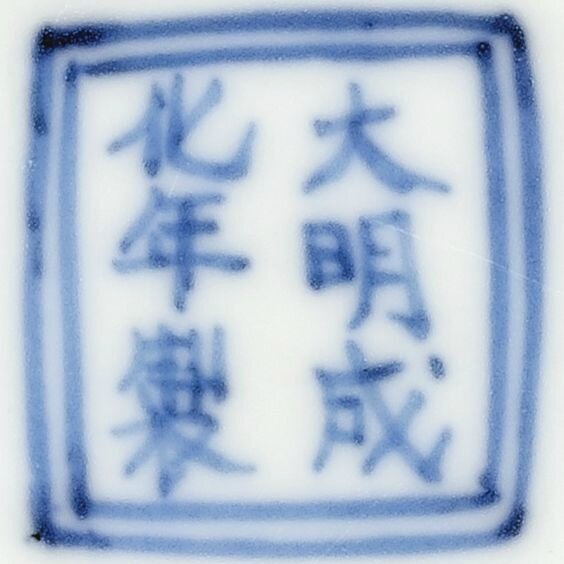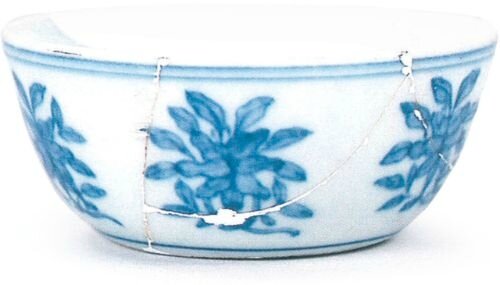![An Exquisite Copper-Red ‘Three Fish’ Stem Cup]()
![1]()
![1]()
![1]()
![1]()
![1]()
![1]()
![1]()
![1]()
Lot 3610. An Exquisite Copper-Red ‘Three Fish’ Stem Cup, Mark and Period of Xuande (1426-1435). Diameter 11.7 cm. Est. HK$30 million – 40 million / US$3.8 – 5.1 million. Photo: Sotheby's.
exquisitely potted with steep rounded sides rising to a flared rim, supported on a hollow splayed foot, the exterior precisely applied with thick copper-red splashes with a vibrant design of three stylised fish depicted in silhouette, two of the fish portrayed facing each other, the other swimming in the opposite direction of the other two, creating the illusion of three different pairs of fish, covered overall save for the footring with a translucent glaze with a characteristic 'orange peel' surface, the unglazed footring showcasing the smooth white body, the interior of the cup inscribed in underglaze blue with a six-character reign mark within a double circle - d. 11.7 cm, 4 5/8 in.
Provenance: Sotheby's London, 9th November 1954, lot 71.
Christie's London, 8th December 1975, lot 130.
Collection of Edward T. Chow (1910-80).
Sotheby's Hong Kong, 25th November 1980, lot 45.
Family Collection of T.Y. Chao (1912-99).
Sotheby's Hong Kong, 18th November 1986, lot 30.
Sotheby's Hong Kong, 10th April 2006, lot 1661.
Exhibited: The Arthur M. Sackler Museum, Harvard Art Museums, Cambridge, Massachusetts, 2007-13, on loan.
The Nelson-Atkins Museum of Art, Kansas City, Minnesota, 2013-15, on loan.
A Xuande Masterpiece
Regina Krahl
The mastery of copper-red glaze designs, such as the three fishes on this stem cup was one of the special achievements of the imperial potters of the Xuande reign (1426-35) and was not repeated to this standard in any other period. The radical simplicity of this three-fish and related three-fruit designs is without par in the history of Chinese porcelain decoration and exceptional among Chinese imperial works of art. As a porcelain design, it was dictated largely by technical considerations, as the potters aimed at achieving the deepest, most intense red available with copper pigment. As an artistic concept, however, it was not totally without precedent in Chinese art and would not have caught the Xuande Emperor completely unawares.
Unassuming though it seems, its stark simplicity has been enlivened by a simple yet highly efficient trick: by letting one fish swim in the opposite direction from the other two, three different pairs of fish appear on the cup: a pair swimming towards each other, a pair pursuing each other, and a pair swimming away from each other, thus effortlessly achieving variation and avoiding repetition. To create the utmost effect with the most limited means is a characteristic trait of much Chinese art, well known particularly from ink painting. And although no ink painting of quite such bareness is known from this early date, the concept is not alien to Chinese Chan (Zen) painting and recalls the Six Persimmons by the 13th-century monk artist Muqi.
Fish play an important role as symbols in Chinese thought. In Chan Buddhism many stories revolve around them that are quoted as reasons for the use of a wooden fish as a gong in monasteries to call monks and nuns to prayer and to mark other activities; in Daoism, fish are the ultimate image of a glorified freedom from restraints; and in Confucian thought they immediately evoke the scholar succeeding in the imperial exams and thus assuring success in life, like the mythical carp swimming up-river and turning into a dragon.
After varied results in the Yuan dynasty (1279-1368) and Hongwu reign period (1368-98), the first impeccable reds were reached at the Jingdezhen imperial kilns in the Yongle reign (1403-24). Already in the Yuan dynasty, red glaze was used to decorate stem cups, but no attempt was made to lend shape to red splashes. Thus is the case with a revolving stem cup discovered among the hoard of Yuan porcelain at Gao’an, Jiangxi province, which is dramatically but unevenly splashed with copper-red pigment, but in a different technique, which did not render the red anywhere near as bright (see Liu Jincheng, ed., Gaoan Yuandai jiaocang ciqi/The Porcelain from the Cellar of the Yuan Dynasty in Gao’an, Beijing, 2006, pp. 70-71).
Copper-red pigment used for painted designs under the glaze, and copper-red glaze applied all over the vessel were both brought to the highest standard in the Yongle reign and often passed the extreme expectations of the court; but the Yongle period was a time of experimentation at the imperial kilns, when tests were undertaken with many different materials and techniques, and a considerable part was quickly rejected and destroyed again before perfection was reached. As red glazes yielded a stronger result than red pigment used for underglaze painting, additional attempts were made to use the red glaze for painting with the brush, for which it is believed to have been sandwiched between two layers of transparent glaze. Several ambitious concepts were followed up, many of them abandoned when they proved unsatisfactory, but some retained even though the red did not fire perfectly well all the way round – an extremely rare occasion in this period and proof of the immense efforts such wares entailed. A Yongle stem cup with three fish of red glaze among underglaze-blue waves, and a stem bowl painted in red glaze with dragons and a formal border, for example, were both abandoned at the kiln site (their re-assembled fragments included in the exhibition Jingdezhen Zhushan chutu Yongle guanyao ciqi [Yongle Imperial porcelain excavated at Zhushan, Jingdezhen], Capital Museum, Beijing, 2007, cat. nos 113 and 11). The magnificent large Yongle meiping with white dragons reserved among red waves, formerly in the Meiyintang and now the Xiling collection, on the other hand, probably the most ambitious project ever undertaken in this red glaze decoration technique, was retained even though not all the waves have turned a bright colour (Regina Krahl, ‘China without Dragons. An Exhibition of the Oriental Ceramic Society’, Orientations, vol. 47, no. 8, November-December 2016, p. 98, fig. 10).
In the Xuande reign, the potters appear to have realised that painting with a red glaze could work well as long the designs were reduced to distinct silhouettes. This is when cups, stem cups and stem bowls with three red fish or three red fruit only, without any accompanying decoration and lacking even the customary underglaze-blue lines around rim and foot, began to be produced. The admirable, jewel-like colour and texture of these silhouettes was achieved only in the Xuande reign and was not matched again even in the Qing dynasty (1644-1911), when these designs were frequently copied, particularly in the Yongzheng (1723-35) and Qianlong (1736-95) eras.
Although very well executed examples with red glaze decoration such as the present piece are known from the Xuande period, the numbers remained very small and more examples may have been destroyed than were deemed successful and preserved. Many deliberately broken stem cups, stem bowls and cups with red fish, red fruit, red dragons or other sea creatures, all of Xuande mark and period, have been recovered from the waste heaps of the Ming imperial kiln site (some of them included in the exhibitions Imperial Porcelain of the Yongle and Xuande Periods Excavated from the Site of the Ming Imperial Factory at Jingdezhen, Hong Kong Museum of Art, Hong Kong, 1989, cat. nos 55, 75 and 76, and Jingdezhen chutu Ming Xuande guanyao ciqi/Xuande Imperial Porcelain excavated at Jingdezhen, Chang Foundation, Taipei, 1998, cat. nos. 45-1 and 2, 46-1 and 2, 49-1 and 2, 101-1, 2 and 3, and F 9). Attempts were also made to replace the copper-red with an overglaze iron red, which, however, equally did not always yield the desired result (e.g. cat. no. 77 in the former catalogue, cat. no. 48-1 in the latter).
The present piece, with its generous, deep cup shape, is a particularly rare example. Only one companion piece appears to be recorded, in the National Palace Museum, Taipei, published in Mingdai Xuande guanyao jinghua tezhan tulu/Catalogue of the Special Exhibition of Selected Hsüan-te Imperial Porcelains of the Ming Dynasty, Taipei, 1998, cat. no. 87 (fig. 1), together with a ‘red fruit’ example of the same form, cat. no. 86, as well as smaller and more shallow stem cups with three copper-red fishes, cat. no. 81, with three iron-red fishes, cat. no. 82, as well as stem bowls with the same copper-red fruit or fish design, cat. nos 98 and 99; another smaller ‘red fish’ stem cup was included in the Museum’s exhibition Ming Xuande ciqi tezhan mulu/Catalogue of a Special Exhibition of Hsuan-te Period Porcelain, National Palace Museum, Taipei, 1980, cat. no. 124, where it is illustrated together with a later copy, cat. no. 126, as well as later copies of ‘fruit’ stem cups, cat. nos 125 and 127.
![Copper-red ‘fish’ stem cup, mark and period of Xuande © Collection of National Palace Museum, Taipei]()
fig. 1. Copper-red ‘fish’ stem cup, mark and period of Xuande© Collection of National Palace Museum, Taipei
The Palace Museum, Beijing, also holds only a smaller and more shallow stem cup of this design, see The Complete Collection of Treasures of the Palace Museum. Blue and White Porcelain with Underglazed Red, Shanghai, 2000, vol. 1, pl. 226, with a detail on p. 246; another smaller example in the Shanghai Museum is published in Lu Minghua, Shanghai Bowuguan zangpin yanjiu daxi/Studies of the Shanghai Museum Collections : A Series of Monographs. Mingdai guanyao ciqi [Ming imperial porcelain], Shanghai, 2007, pl. 3-52; and one from the Eumorfopoulos Collection in the Victoria and Albert Museum is illustrated in Daisy Lion-Goldschmidt, Ming Porcelain, London, 1978, col. pl. 61; another stem cup of this smaller form, from the collection of Allen J. Mercher, the Chang Foundation, Taipei, and the Chunzaizhai Collection, illustrated in James Spencer (comp.), Selected Chinese Ceramics from Han to Qing Dynasties, Chang Foundation, Taipei, 1990, cat. no. 90, was sold in our New York rooms, 2nd November 1956, lot 223; and in these rooms 14th November 1983, lot 126, and 8th October 2014, lot 3001.
A ‘three fish’ stem cup of the same deep shape as the present piece is also depicted in one of the Guwantu [Pictures of Antiquities] among other items in the imperial collection in the Yongzheng period, its stem firmly locked in a tall wooden stand to keep it safe. The scroll, dated in accordance with AD 1728, is preserved in the British Museum from the Sir Percival David Collection and was sold in our London rooms, 19th May 1939, lot 62; see the exhibition catalogue China. The Three Emperors 1662-1795, Royal Academy of Arts, London, 2005-6, cat. no. 168 top left (fig. 2). The Yongzheng Emperor also appears to have commissioned copies of this design, where the fishes, however, often show a less attractive liver-red colour.
![1]()
fig. 2. Anonymous court artists, Pictures of Ancient Playthings, ink and colours on paper, handscroll, detail, Qing dynasty, Yongzheng period© The Trustees of the British Museum
The present stem cup comes from two of the most remarkable collections of Chinese ceramics, those of Edward T. Chow (1910-80) and T.Y. Chao (1912-99). Edward Chow, a connoisseur-dealer who had worked in Shanghai and Hong Kong before settling in Switzerland, had furnished and helped to shape some of the most important collections of Chinese art, such as those of Sir Percival David, Barbara Hutton, King Gustav Adolf of Sweden, J.M. Hu, or Ataka Eiichi. The three sales of his personal collection at Sotheby’s Hong Kong and London in 1980 and 1981 remain among the most remarkable and successful auctions of Chinese art, which exerted a strong influence on the art market in Hong Kong. One of the most eager buyers at these sales was T.Y. Chao, a shipping magnate, who clearly took Edward T. Chow as a model in forming his own collection. When the T.Y. Chao Family collection was sold in these rooms in 1986, it echoed the Chow sales of a few years earlier.
Sotheby's. Important Chinese Art, Hong Kong, 05 avr. 2017, 02:30 PM






















































